
Delivering food to children in rural Kenya
Mary’s Meals school feeding programme is enabling pre-school children in the Turkana region of Kenya to receive an education.
I’ve lived in Nairobi most of my life. But growing up in Kenya’s capital city you don’t hear much about Turkana, other than it’s an area in which the population follows nomadic pastoralism – the traditional practice of keeping and moving with their livestock.
As the largest county in Kenya by area, Turkana is situated in the northwest part of the country, bordering Ethiopia, Uganda, and South Sudan. It's an underdeveloped area with poor infrastructure, consisting of mainly arid and semi-arid land where the people live under the constant threat of conflict and drought, and regularly face poverty and hunger.
It’s also an area in which Mary’s Meals provides a nutritious, daily meal for children at early childhood development centres (ECD), enabling nomadic families in the region to remain in their communities during drought season and send their children to school.
So, when Mary’s Meals decided to make a short film about the challenges of pastoralism and how it provides a daily meal for children in ECDs in Turkana, I jumped at the chance to help. This article documents my trip with the Mary’s Meals programme operations team to deliver food to three ECDs in Turkana.
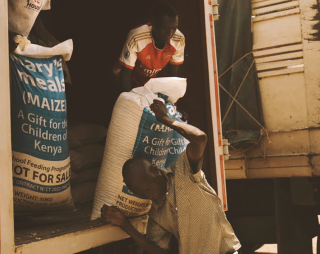
Day 1 – arrival in Turkana
We started with a two-hour flight from Nairobi to Lodwar, the capital of Turkana County, and were met by Vincent Wekesa – Mary’s Meals’ Programme Operations Lead in Kenya.
Vincent took us to Mary’s Meals’ warehouse and explained the process of distributing food to over 750 schools across Turkana. He explained that our warehouse receives sacks of grain from all over Kenya and samples from different sacks are tested by a public health officer to ensure the grain meets the right standards for consumption.
Once these quality checks are complete, the grain is loaded onto trucks and prepared for its long journey to ECDs across Turkana.
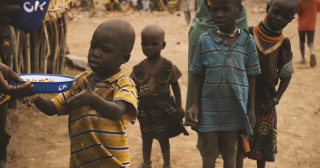
Day 2 – transporting food to schools in rural Kenya
We set off at 6am with sacks of grain for Lokwarangipiro ECD – a journey across harsh, desert-like landscape and dry riverbeds to Lake Turkana, where we took a 35-minute boat ride to get to the school. Although Lake Turkana is the world’s largest desert lake, it is also the world’s largest alkaline lake and unsuitable to be used for drinking water or irrigation.
As we arrived, we were welcomed by the local community singing songs, and I could see from their smiles how happy they were to meet us. The men and women carried the 50kg sacks from the lakeside to the school, and by the time we had walked up to the school the meals were already being prepared.
The children queued barefoot under the hot sun and took turns washing their hands from a jerrycan. Some were crying and the mood was downbeat. They received their meal and carried it into the classroom. But once they started to eat, the whole atmosphere changed. They were more friendly and wanted to interact with us and socialize with each other. They started conversing and laughing, and ran outside to play once they had eaten.
This is the power of a nutritious meal, I thought to myself, as we drove back to Lodwar. This is how every child should be – free from hunger and living to their fullest potential, while also receiving an education.
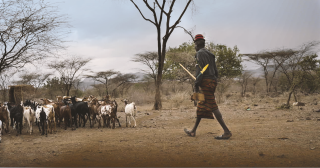
Day 3 – the promise of food offers opportunity for change
We woke up at 4am for 2.5-hour journey to Naurendudung ECD up in the hills near the Ugandan border. The terrain was extremely dusty and dry, and most families in the region regularly cross into Uganda in search of grazing land during times of drought.
We stopped in what seemed like the middle of nowhere and were met by Wilson – a Mary’s Meals’ school feeding officer. He explained that the school itself has no permanent structure, and the children have lessons outside facing a blackboard resting against a tree. In the school compound, a structure of branches served as makeshift kitchen walls, a manyatta (a hut of mud and straw) housed the food store and another structure served as the school's maternity unit.
As we arrived, the children started coming down from the hills surrounding the school wearing traditional "shuka" clothing and beaded, tribal necklaces. They carried empty food containers, left them hanging on the straw thatch and went to the classroom area where they sat on the ground facing the blackboard. They looked tired and dispirited, as they hadn't yet eaten.
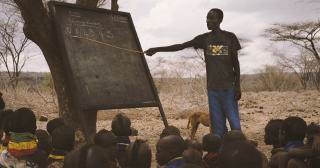
While the children were having their morning lesson, we met some of the community elders. Peter, the leader of the community, welcomed us to his village and explained that many of the children were often tired in lessons as they had to walk over 8km every morning to fetch water for their families and livestock. He also told us that the education the children receive will enable them to gain better employment in the future, which will help them contribute to local development of the region.
Once the morning lesson has finished, Dominic – a volunteer teacher – tells us about the importance of education within the community. He talks passionately about how crucial Mary's Meals is to ensuring attendance, saying that without it, many children wouldn’t attend. He considers Mary's Meals as a catalyst for change in the community.
At lunchtime, the children lined up to receive their meal. The older ones fed the younger ones, and they all chatted enthusiastically, laughing between mouthfuls. Once again, I saw the change in mood after the children had been served food – and it was wonderful to witness joy and positive energy on the children’s faces.
As we travelled back to Lodwar at the end of a long day, my main thoughts were – although these children had no roof over their heads, no walls to block out the wind or sun and no books to study from, they were eager to learn and hopeful that the future would be brighter.
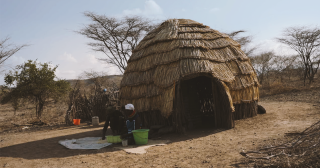
Day 4 – investing in education helps fight poverty
It was already sweltering when we visited Methewani Naotin ECD in Lodwar in the morning.
We met up with Susan, a Mary’s Meals school feeding officer, who told us the story of Albert Nakacho, a man from Lodwar who didn't go to school, so started his own school to give the children from his community an education. The school has grown from just 15 pupils taught under a tree to 670 pupils. He explained that through the food that Mary’s Meals provides, the school had almost become like a mother to the children.
We also met the sub-county education officer for Turkana who told us how Mary’s Meals is not only important for the children, but for the whole community. He talked about his belief that investing in early childhood education is the foundation for fighting poverty and the basis on which to create a strong society.
Grains of Hope – an opportunity for change in Turkana
My trip to Turkana really opened my eyes to learning more about my own country and the challenges of pastoralism as a way of life faced by people in Turkana.
And I’m really pleased that Grains of Hope, the short film I helped to create, has recently been released – you can watch it here. The film highlights how Mary’s Meals school feeding programme and the promise of food in their place of education provides food security and stability to families and communities in the region, enabling the children of Turkana to get an education. This, in turn, offers the opportunity for positive change and growth in the region.
Finally, I’d like to say a massive thank you to my Mary’s Meals colleagues who also went on this trip to deliver food to Turkana – Graeme Bradley, Shona Shea, Anne Mwangi and Alan Melrose.
Christine Atoto is Assistant Video Editor at Mary’s Meals International. She produces compelling visual content that highlights the organisation's impactful work and helped with additional filming and sound work for Grains of Hope.
Learn more about our work in Kenya and how the promise of a daily meal in their place of education enables the children of Turkana to receive an education.

